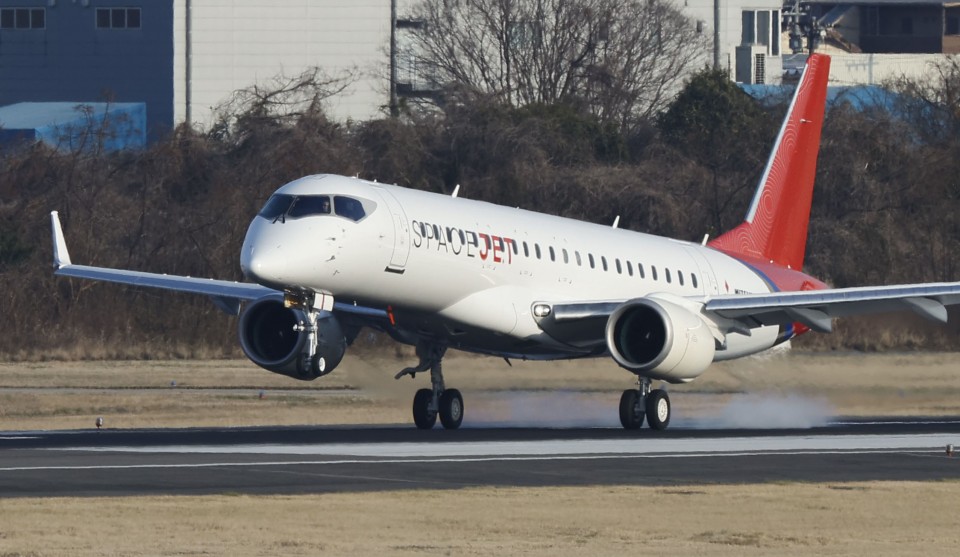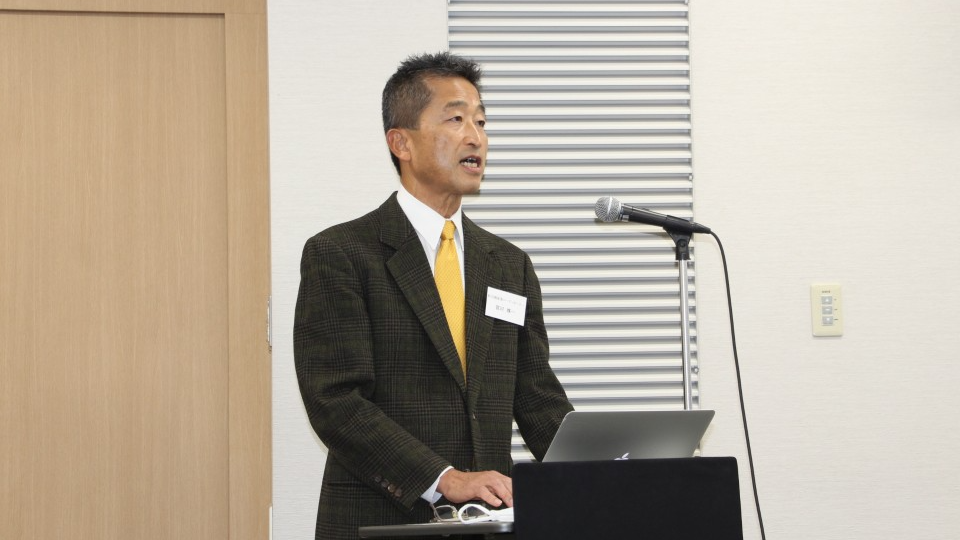beijingwalker
ELITE MEMBER

- Joined
- Nov 4, 2011
- Messages
- 65,191
- Reaction score
- -55
- Country
- Location
Ex-SpaceJet engineer trains next generation after project freeze, Japan's ambition to rank with the United States and Europe in aircraft manufacturing was over

When Mitsubishi Heavy Industries Ltd. froze its project to develop the Mitsubishi SpaceJet, Japan's first domestically manufactured passenger jet, in the fall of 2020, it looked like Japan's ambition to rank with the United States and Europe in aircraft manufacturing was over.
Launched in 2008, the project to develop the small-size plane for 70-90 passengers was hit by repeated delays caused by a lack of production know-how and supply chain issues. The COVID-19 pandemic dealt it a final blow by wiping out demand for commercial airplanes across the globe.

Photo shows Junichi Miyakawa, an engineer formerly involved in the development of the Mitsubishi SpaceJet, speaking in front of participants in a course to train the next generation of aircraft industry professionals in Nagoya, central Japan, on Nov. 9, 2021. (Kyodo)
The company slashed the budget and the workforce, leaving only enough to maintain some test airplanes in its facilities and examine accumulated flight test data. Many people thought the future of Japan's aircraft manufacturing industry was doomed.
Not Junichi Miyakawa. Last fall, the 67-year-old engineer, formerly involved in the project, launched a course designed to share knowledge of airplane manufacturing with future industry professionals and keep the ambition alive.
"The aircraft industry is definitely going to make a comeback in the future," Miyakawa said in a recent interview. "I want to pass on the efforts we've made to the next generation."
The course, held both online and in Nagoya, central Japan, near Mitsubishi's assembly plant for Mitsubishi SpaceJet, covers a broad range of areas such as aircraft design, supply chain management, and marketing. It started last October and is scheduled to end in March.
The program, consisting of 16 lectures, invites professionals in various fields, including an engineer at the Japan Aerospace Exploration Agency and a former top official at ANA Holdings Inc., to talk about their fields of expertise.
Participants learn not only about the technical aspects of building aircraft but also get an overview of the industry, something that Miyakawa believes is key to developing successful engineers and other professionals.
Miyakawa explained that in the future, they must focus not only on narrow technical areas but also look beyond their fields of specialization.
"You also have to look into the far distance. You have to have bifocal glasses," he said.
Miyakawa, a native of Tokyo, was born nine years after World War II. Like many children then, Miyakawa grew up building plastic models of Japanese military planes like the Zero fighter.
His vague interest in airplanes took shape after his friend's brother, a pilot, took him on a flight around Tokyo in a Cessna when he was 18. He was fascinated by the beautiful view of Izu Oshima Island, south of Tokyo, from above.
"He even made circles above my house," he said. "That flight left a really strong impression on me."
After studying aeronautics at the University of Tokyo, Miyakawa joined Mitsubishi Heavy Industries in 1978.

File photo shows a Mitsubishi SpaceJet test plane traveling along a runway at Nagoya airport in Toyoyama in Aichi Prefecture, central Japan, on March 18, 2020. (Kyodo)
A thriving industry during wartime, Japan's aircraft manufacturing fell into decline after the General Headquarters of the Allied Forces introduced a seven-year ban on making airplanes in the aftermath of World War II.
Although there have been some attempts to develop commercial airplanes, Japanese aircraft making has primarily revolved around producing Air Self-Defense Force planes along with supplying parts to giants such as Boing Co. and Airbus SE.
In an attempt to turn it into a growth industry, Mitsubishi Heavy, backed by Japan's Ministry of Economy, Trade and Industry, launched a project to make the country's first domestically manufactured passenger jet in 2008.
The Mitsubishi Regional Jet was set to be Japan's first passenger airplane in half a century after the YS-11 turboprop flew for the first time in 1962. Amid growing hopes among government officials and business circles, it virtually became a national project.
The aircraft, later renamed Mitsubishi SpaceJet, was designed for close to medium distance flights, boasting high fuel efficiency helped by new-generation engines.
The company said it planned to take a 40-50 percent share in the global small aircraft market dominated by Canada's Bombardier Inc. and Brazil's Embraer SA.
To achieve such an ambition, the company appointed Miyakawa as its first project manager. "It came out of the blue," he said, as he had a long career in military aircraft development.
After working on the aircraft's basic design, Miyakawa took charge of sales marketing, winning orders from regional airlines such as U.S.-based Trans States Holdings Inc. The number of orders rose to more than 400 at its peak.
However, initially scheduled for 2013, the delivery date was pushed back six times as the airplane went through repeated design changes to improve its safety. According to people familiar with the matter, development costs kept soaring, reaching about 1 trillion yen ($8.7 billion).
With no clear exit in sight and faced with shrinking air travel demand caused by the pandemic, the top management decided to put the project on hold in October 2020, saying "it will pause it for the moment," without specifying when it will resume.
"We made an airplane of some quality, but we lacked know-how and experience needed to obtain (the certification necessary for commercial flights)," Mitsubishi Heavy President Seiji Izumisawa told reporters at the time.
The decision devastated its engineers. "It was so close to completion. It was like my baby," said Miyakawa, who had already retired from the company by then.
Experts say that while Mitsubishi, the maker of the Zero fighter plane during WWII, had the technical abilities to make airplanes, it underestimated the difficulty of obtaining type certification -- signifying the airworthiness of a particular category of aircraft.
Japan's transportation ministry supervises the process but heavily draws on a similar procedure of the Federal Aviation Administration in the United States as the Japanese ministry had no previous experience reviewing certification for a domestically manufactured passenger jet.
Mitsubishi's struggles came from a lack of knowledge about how to meet each procedure requirement, leading to continual design changes.
"It was so different from making SDF planes," a former senior official involved in the project has said.
According to the experts, Mitsubishi's corporate culture of developing products on its own without seeking outside help also added to the difficulties.
Miyakawa's course seems to draw on such past mistakes.
Rather than just teaching about how to make airplanes, it tries to train students to be versatile in a broad array of topics like market and customer trends, airline and airport management, and even how flying cars and electric aircraft could change the industry.
To date, the course, which is offered through the Nagoya Chamber of Commerce and Industry, has attracted more than 100 participants, including current engineers in the aircraft industry, students, and small-business owners considering entering the industry.
"I wanted to have a framework to pass on the knowledge and know-how I acquired through developing the MRJ to the next generation," Miyakawa said. "I'm really happy young people involved in airplane making are actually taking this course."
Miyakawa says it takes time to train engineers, but once a certain skill level is achieved in a country as a whole, the potential for the future is limitless. The resumption of the Mitsubishi SpaceJet project would make that dream a reality, he said.
"I really want the company to come up with ways to continue (the development) at any cost," he said. "We were so close to the mountain top. Why would we go back to the base of it?"

FEATURE: Ex-SpaceJet engineer trains next generation after project freeze
When Mitsubishi Heavy Industries Ltd. froze its project to develop the Mitsubishi SpaceJet, Japan's first domestically manufactured passenger jet, in the fall of 2020, it looked like Japan's ambition to rank with the United States and Europe in aircraft manufacturing was over.

